Publications
.
Filter by type:
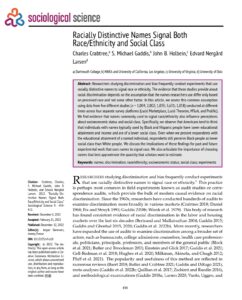
Racially Distinctive Names Signal Both Race/Ethnicity and Social Class
Abstract
Researchers studying discrimination and bias frequently conduct experiments that use racially distinctive names to signal race or ethnicity. The evidence that these studies provide about racial discrimination depends on the assumption that the names researchers use differ only based on perceived race and not some other factor. In this article, we assess this common assumption using data from five different studies (n = 1,004; 2,002; 1,035; 5,631; 1,858) conducted at different times across four separate survey platforms (Lucid Marketplace, Lucid Theorem, MTurk, and Prolific). We find evidence that names commonly used to signal race/ethnicity also influence perceptions about socioeconomic status and social class. Specifically, we observe that Americans tend to think that individuals with names typically used by Black and Hispanic people have lower educational attainment and income and are of a lower social class. Even when we present respondents with the educational attainment of a named individual, respondents still perceive Black people as lower social class than White people. We discuss the implications of these findings for past and future experimental work that uses names to signal race. We also articulate the importance of choosing names that best approximate the quantity that scholars want to estimate.
Keywords
- Names
-
Racial/ethnic discrimination
-
Audit studies
- Experiments
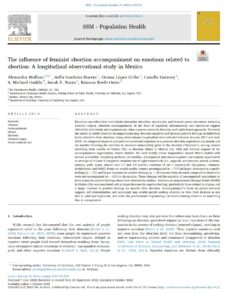
The Influence of Feminist Abortion Accompaniment on Emotions Related to Abortion: A Longitudinal Observational Study in Mexico
Abstract
Emotions can reflect how individuals internalize identities, social roles, and broader power structures, including abortion stigma. Abortion accompaniment, in the form of logistical, informational, and emotional support offered by individuals and organizations, takes a person-centered, feminist, and rights-based approach. We tested the extent to which abortion accompaniment may decrease negative and increase positive feelings an individual holds related to their abortion. Using observational longitudinal data collected between January 2017 and mid-2018, we compared negative and positive emotional responses to a personal abortion experience one month and six months following the abortion to emotions immediately prior to the abortion (“baseline”), among women travelling from outside of Mexico City to abortion clinics in Mexico City with and without support of the accompaniment organization, Fondo MARIA. We used doubly robust longitudinal mixed effects models with inverse probability weighting methods. At baseline, accompanied and unaccompanied participants experienced an average of 4.9 and 4.4 negative emotions out of eight respectively (i.e., anguish, nervousness, scared, anxious, sadness, guilt, anger, shame) and 1.7 and 1.9 positive emotions of out 4 respectively (happiness, calmness, decidedness, and relief). From our model results, women accompanied (n = 77) had larger decreases in negative feelings (p < .05) and larger increases in positive feelings (p < .01) toward their abortion compared to those who were not accompanied (n = 119) at six months. These changes led the majority of accompanied respondents to have primarily positive feelings about their abortion by endline. Abortion accompaniment through Fondo MARIA in Mexico City was associated with a larger decrease in negative feelings, particularly those related to stigma, and a larger increase in positive feelings six months after abortion. Accompaniment’s focus on person-centered support, self-determination, and autonomy may enable people seeking abortion to view their decision as one that is valid and legitimate, and resist the predominant stigmatizing narratives framing abortion as something that is transgressive.
Keywords
- Abortion
-
Stigma
-
Accompaniment
- Emotions
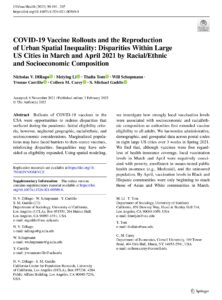
COVID-19 Vaccine Rollouts and the Reproduction of Urban Spatial Inequality: Disparities Within Large U.S. Cities in March and April 2021 by Racial/Ethnic and Socioeconomic Composition
Abstract
Rollouts of COVID-19 vaccines in the U.S. were opportunities to redress disparities that surfaced during the pandemic. Initial eligibility criteria, however, neglected geographic, racial/ethnic, and socioeconomic considerations. Marginalized populations may have faced barriers to then-scarce vaccines, reinforcing disparities. Inequalities may have subsided as eligibility expanded. Using spatial modeling, we investigate how strongly local vaccination levels were associated with socioeconomic and racial/ethnic composition as authorities first extended vaccine eligibility to all adults. We harmonize administrative, demographic, and geospatial data across postal codes in eight large U.S. cities over three weeks in Spring 2021. We find that, although vaccines were free regardless of health insurance coverage, local vaccination levels in March and April were negatively associated with poverty, enrollment in means-tested public health insurance (e.g., Medicaid), and the uninsured population. By April, vaccination levels in Black and Hispanic communities were only beginning to reach those of Asian and White communities in March. Increases in vaccination were smaller in socioeconomically disadvantaged Black and Hispanic communities than in more affluent, Asian, and White communities. Our findings suggest vaccine rollouts contributed to cumulative disadvantage. Populations that were left most vulnerable to COVID-19 benefited least from early expansions in vaccine availability in large U.S. cities.
Keywords
- COVID-19
-
Racial inequality
-
SES inequality
- Geographic composition
Signaling Class: Two Survey Experiments Examining Social Class Perceptions from Names Used in Racial-Bias Experiments
Abstract
I conduct two survey experiments to examine whether demographic naming patterns predict individual perceptions about the social class of people who have those names. In the primary study, respondents are randomly presented with names and asked to state the social class they associate with each name. In total, 7,697 respondents provide 102,788 social class perceptions on 876 different combinations of first and last names. I use New York State demographic birth record data capturing information on mothers’ race/ethnicity and educational attainment for millions of births in the state over 18 years. I find that the percent of non-White mothers and percent of mothers with a college degree predict respondents’ social class perceptions of names. I find larger differences in social class perceptions among Black rather than White and Hispanic names. This research sheds light on how people perceive characteristics from names and has substantial implications for racial bias research.
Keywords
-
Social class
-
Racial/ethnic discrimination
-
Names
-
Audit Studies
- Experiments
Discrimination Against Black and Hispanic Americans is Highest in Hiring and Housing Contexts: A Meta-Analysis of Correspondence Audits
Abstract
To what extent does racial/ethnic discrimination in America differ across contexts? In this paper, we provide the largest and most comprehensive review of racial/ethnic discrimination research to date. We conducted a meta-analysis of 78 correspondence audits in the United States, representing over half a million applications, emails, and other forms of correspondence that occur in all aspects of modern society, including the hiring, housing, medical, public services, and education sectors. We find that racial/ethnic discrimination in the United States continues to be a large problem, but discrimination against racial/ethnic minorities simultaneously exhibits a substantial amount of contextual heterogeneity not recognized in previous discrimination research. Discrimination against Black Americans is most common in hiring, followed by the rental housing context. Discrimination against Hispanic Americans is highest in hiring, but discrimination in other contexts is considerably lower. Although discrimination occurs in education, medical, and public services contexts, it is far less common in these sectors. Altogether, our findings suggest that discrimination is more common in economic contexts that are more resource-intensive and have higher stakes, despite stronger legal protections against discrimination in those same contexts. Our work confirms that racial/ethnic discrimination in the United States continues to be a persistent and pervasive phenomenon that impacts many core parts of the lives of Black and Hispanic Americans and simultaneously reinforces and exacerbates existing inequalities.
Keywords
- Racial/ethnic discrimination
-
Correspondence audits
-
Field experiments
- Meta-analysis
Changes Over Time in COVID-19 Vaccination Inequalities in Eight Large U.S. Cities
Abstract
We estimate the associations between community socioeconomic composition and changes in COVID-19 vaccination levels in eight large cities at three time points. Between March and April, low SES communities had significantly lower change in percent vaccinated than high SES communities. Between April and May, this difference was not significant. Thus, the large vaccination gap between communities during restricted vaccine eligibility did not narrow when eligibility opened up. The link between COVID-19 vaccination and community disadvantage may lead to a bifurcated recovery where advantaged communities move on from the pandemic more quickly while disadvantaged communities continue to suffer.
Keywords
- COVID-19
-
Neighborhood inequality
-
SES inequality
- Geographic composition
Chinese Americans Faced High Levels of Discrimination in Public Schools Before the COVID-19 Pandemic
Abstract
In the wake of the COVID-19 pandemic, accounts of violence against Asians–and those of Chinese descent especially–have risen dramatically. These disturbing episodes have sparked a rapidly growing research agenda that uses well-controlled research designs to explore the extent, nature, and origins of hostility against Asian Americans in the current moment. Unfortunately, however, researchers undertook few such well-controlled studies examining discrimination against Asian Americans in the years before the COVID-19 pandemic. Thus, scholars have limited experimental evidence upon which to understand and benchmark recent research. We examine data from two large-scale, independently conducted correspondence audits of public school principals before the pandemic. Our research provides clear evidence that discrimination against individuals of Chinese descent in the U.S. is definitively not a new phenomenon driven only by the COVID-19 outbreak. This discrimination is large and widespread in American public schools. Moreover, we find that among public school principals, discrimination against Asian Americans is considerably larger than discrimination against Hispanic and Black Americans. Additionally, discrimination against Asian Americans is larger in areas that have greater shares of White and Republican-voting populations. Our evidence shows that discrimination against Asian Americans is systemically present and does not vary by local mean income or educational attainment. Our two large experiments show that in vitally important contexts, Asian Americans have faced deeply troubling, yet subtle and hard to detect, levels of discrimination that are large by any standard of reference. Discrimination against Asians is an enduring aspect of life in the United States.
Keywords
- Correspondence audits
-
Asian Americans
-
Racial discrimination
- Public schools
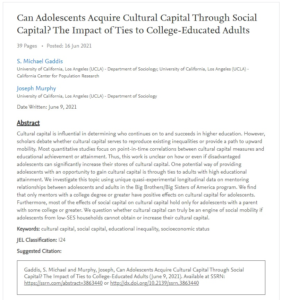
Can Adolescents Acquire Cultural Capital Through Social Capital? The Impact of Ties to College-Educated Adults
Abstract
Cultural capital is influential in determining who continues on to and succeeds in higher education. However, scholars debate whether cultural capital serves to reproduce existing inequalities or provide a path to upward mobility. Most quantitative studies focus on point-in-time correlations between cultural capital measures and educational achievement or attainment. Thus, this work is unclear on how or even if disadvantaged adolescents can significantly increase their stores of cultural capital. One potential way of providing adolescents with an opportunity to gain cultural capital is through ties to adults with high educational attainment. We investigate this topic using unique quasi-experimental longitudinal data on mentoring relationships between adolescents and adults in the Big Brothers/Big Sisters of America program. We find that only mentors with a college degree or greater have positive effects on cultural capital for adolescents. Furthermore, most of the effects of social capital on cultural capital hold only for adolescents with a parent with some college or greater. We question whether cultural capital can truly be an engine of social mobility if adolescents from low-SES households cannot obtain or increase their cultural capital.
Keywords
-
Cultural capital
-
Social capital
-
Educational inequality
-
Socioeconomic status (SES)
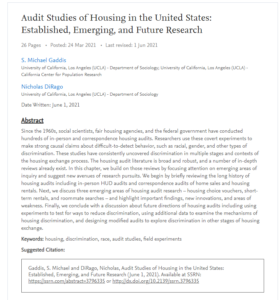
Audit Studies of Housing Discrimination in the United States: Established, Emerging, and Future Research
Abstract
Since the 1960s, social scientists, fair housing agencies, and the federal government have conducted hundreds of in-person and correspondence housing audits. Researchers use these covert experiments to make strong causal claims about difficult-to-detect behavior, such as racial, gender, and other types of discrimination. These studies have consistently uncovered discrimination in multiple stages and contexts of the housing exchange process. The housing audit literature is broad and robust, and a number of in-depth reviews already exist. In this chapter, we build on those reviews by focusing attention on emerging areas of inquiry and suggest new avenues of research pursuits. We begin by briefly reviewing the long history of housing audits including in-person HUD audits and correspondence audits of home sales and housing rentals. Next, we discuss three emerging areas of housing audit research – housing choice vouchers, short-term rentals, and roommate searches – and highlight important findings, new innovations, and areas of weakness. Finally, we conclude with a discussion about future directions of housing audits including using experiments to test for ways to reduce discrimination, using additional data to examine the mechanisms of housing discrimination, and designing modified audits to explore discrimination in other stages of housing exchange.
Keywords
- Racial/ethnic discrimination
-
Housing inequality
-
Audit Studies
- Experiments
Winmail3: An Automated Email Package with an Application to Correspondence Audit Tests
Abstract
Correspondence audits are a popular method to examine discrimination in a causal framework. However, correspondence audits often require sending hundreds or thousands of emails to subjects. The Winmail3 package allows users to automatically send emails with Stata through PowerShell, which is open-source and cross-platform. Researchers can use this package to perform basic email tasks, such as contacting students or colleagues with standardized messages. Additionally, researchers can perform more complex tasks that entail sending randomized messages with multiple attachments from multiple accounts, tasks that are often necessary to conduct correspondence audit tests. This paper introduces the command and illustrates multiple examples of its application. We believe that researchers can apply this package to correspondence audit tests to save time and money.
Keywords
- Correspondence audits
-
Field experiments
-
Email automation
- Methodology
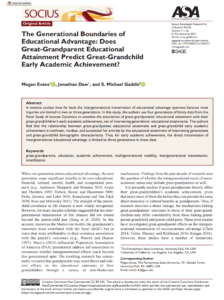
The Generational Boundaries of Educational Advantage: Does Great-Grandparent Educational Attainment Predict Great-Grandchild Early Academic Achievement?
Abstract
It remains unclear how far back the intergenerational transmission of educational advantage operates because most inquiries are limited to two or three generations. In this study, the authors use four generations of family data from the Panel Study of Income Dynamics to examine the association of great-grandparents’ educational attainment with their great-grandchildren’s early academic achievement, net of intervening generations’ educational attainments. The authors find that the relationship between great-grandparent educational attainment and great-grandchild early academic achievement is nonlinear, modest, and accounted for entirely by the educational attainment of intervening generations and great-grandchild demographic characteristics. Thus, for early academic achievement, the direct transmission of intergenerational educational advantage is limited to three generations in these data.
Keywords
- Educational inequality
-
Academic achievement
-
Multigenerational mobility
- Stratification
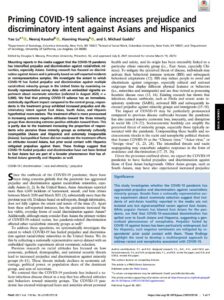
Priming COVID-19 Salience Increases Prejudice and Discriminatory Intent Against Asians and Hispanics
Abstract
Mounting reports in the media suggest that the COVID-19 pandemic has intensified prejudice and discrimination against racial/ethnic minorities, especially Asians. Existing research has focused on discrimination against Asians and is primarily based on self-reported incidents or non-representative samples. We investigate the extent to which COVID-19 has fueled prejudice and discrimination against multiple racial/ethnic minority groups in the United States by examining nationally-representative survey data with an embedded vignette experiment about roommate selection (collected in August 2020; n = 5,000). We find that priming COVID-19 salience has an immediate, statistically significant impact: compared to the control group, respondents in the treatment group exhibited increased prejudice and discriminatory intent against East Asian, South Asian, and Hispanic hypothetical room-seekers. The treatment effect is more pronounced in increasing extreme negative attitudes toward the three minority groups than decreasing extreme positive attitudes toward them. This is partly due to the treatment increasing the proportion of respondents who perceive these minority groups as extremely culturally incompatible (Asians and Hispanics) and extremely irresponsible (Asians). Sociopolitical factors did not moderate the treatment effects on attitudes toward Asians, but prior social contact with Hispanics mitigated prejudices against them. These findings suggest that COVID-19 fueled prejudice and discrimination have not been limited to East Asians but are part of a broader phenomenon that has affected Asians generally and Hispanics as well.
Keywords
- Asian Americans
-
COVID-19
-
Racial prejudice
- Racial discrimination
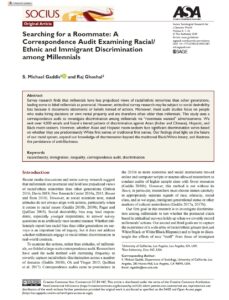
Searching for a Roommate: A Correspondence Audit Examining Racial/Ethnic and Immigrant Discrimination among Millennials
Abstract
Survey research finds that millennials have less prejudiced views of racial/ethnic minorities than other generations, leading some to label millennials as post-racial. However, attitudinal survey research may be subject to social desirability bias because it documents statements or beliefs instead of actions. Moreover, most audit studies focus on people who make hiring decisions or own rental property and are therefore often older than millennials. This study uses a correspondence audit to investigate discrimination among millennials via “roommate wanted” advertisements. We sent over 4,000 emails and found a tiered pattern of discrimination against Asian (Indian and Chinese), Hispanic, and Black room-seekers. However, whether Asian and Hispanic room-seekers face significant discrimination varies based on whether they use predominantly White first names or traditional first names. Our findings shed light on the future of our racial system, expand our knowledge of discrimination beyond the traditional Black/White binary, and illustrate the persistence of anti-Blackness.
Media / Press
- UCLA Newsroom: “Are Millennials Really as ‘Post-Racial’ as We Think?”
- CBS Los Angeles: “Study: Millennials Discriminate Based on Race When Picking Roommates”
- NBC Los Angeles: “UCLA Study Suggests Millennials Show Racial Bias While Looking for Roommates”
- NBC LX (video): “Housing Study Sheds Doubt that Millennials are More Racially Progressive than Previous Generations”
- NBC Miami: “Study Suggests Millennials Show Racial Bias While Looking for Roommates”
- Los Angeles Times: “How to Find a Compatible Roommate”
- The Hidden Brain podcast: “#AirbnbWhileBlack: How Hidden Bias Shapes the Sharing Economy”
Keywords
- Race/ethnicity
-
Immigration
-
Discrimination
- Correspondence audit
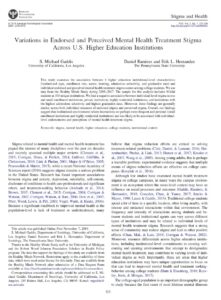
Variations in Endorsed and Perceived Mental Health Treatment Stigma Across U.S. Higher Education Institutions
Abstract
This study examines the association between 6 higher education institutional-level characteristics (institutional type, enrollment size, sector, housing, admissions selectivity, and graduation rate) and individual endorsed and perceived mental health treatment stigma scores among college students. We use data from the Healthy Minds Study during 2009–2017. The sample for this analysis includes 89,644 students at 105 unique institutions. We find a negative association between individual-level stigma scores and small enrollment institutions, private institutions, highly residential institutions, and institutions with the highest admissions selectivity and highest graduation rates. Moreover, these findings are generally similar across both individual measures of endorsed stigma and perceived stigma. Overall, our findings suggest that institutional environments where interactions are perhaps more frequent and personal (small enrollment institutions and highly residential institutions) are less likely to be associated with individual-level endorsements and perceptions of mental health treatment stigma.
Keywords
- Stigma
-
Mental health
-
Higher education
- Institutional context
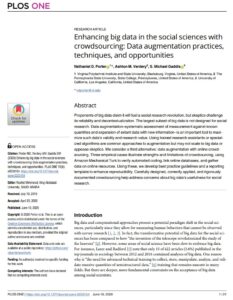
Enhancing Big Data in the Social Sciences with Crowdsourcing: Data Augmentation Practices, Techniques, and Opportunities
Abstract
Proponents of big data claim it will fuel a social research revolution, but skeptics challenge its reliability and decontextualization. The largest subset of big data is not designed for social research. Data augmentation–systematic assessment of measurement against known quantities and expansion of extant data with new information–is an important tool to maximize such data’s validity and research value. Using trained research assistants or specialized algorithms are common approaches to augmentation but may not scale to big data or appease skeptics. We consider a third alternative: data augmentation with online crowdsourcing. Three empirical cases illustrate strengths and limitations of crowdsourcing, using Amazon Mechanical Turk to verify automated coding, link online databases, and gather data on online resources. Using these, we develop best practice guidelines and a reporting template to enhance reproducibility. Carefully designed, correctly applied, and rigorously documented crowdsourcing help address concerns about big data’s usefulness for social research.
Keywords
- Big data
-
MTurk
-
Data augmentation
- Crowdsourcing
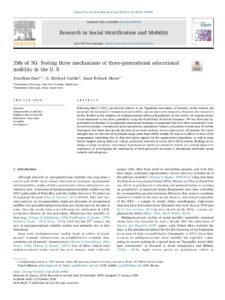
3Ms of 3G: Testing Three Mechanisms of Three-Generational Educational Mobility in the U.S.
Abstract
Following Mare’s (2011) presidential address to the Population Association of America, much research has examined the dynamics of intergenerational mobility and socioeconomic inequality. However, this research is starkly divided on the existence of multigenerational effects and pathways. In this article, we examine educational attainment across three generations using the Panel Study of Income Dynamics. We test three key hypothesized mechanisms of grandparent educational advantage transmission that have been documented in international samples: compensation and augmentation, grandparent lifespan, and genetic transmission. To further interrogate how these mechanisms function across social contexts, we also race-stratify all analyses. As a more stringent test, we also test all hypotheses using cousin fixed effects models. We find no evidence in favor of the compensation hypothesis, but do find descriptive support for the augmentation hypothesis, as well as some limited support among whites for college graduation outcomes in cousin fixed effects models. Findings on the lifespan overlap and genetic transmission hypotheses are highly race-stratified. Overall, our findings support the importance of investigating the mechanisms of three-generation processes of educational attainment across contexts and sub-groups.
Keywords
- Intergenerational mobility
-
Multigenerational mobility
-
Educational attainment
- Inequality
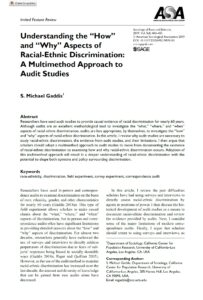
Understanding the “How” and “Why” Aspects of Racial-Ethnic Discrimination: A Multimethod Approach to Audit Studies
Abstract
Researchers have used audit studies to provide causal evidence of racial discrimination for nearly 60 years. Although audits are an excellent methodological tool to investigate the “what,” “where,” and “when” aspects of racial-ethnic discrimination, audits are less appropriate, by themselves, to investigate the “how” and “why” aspects of racial-ethnic discrimination. In this article, I review why audit studies are necessary to study racial-ethnic discrimination, the evidence from audit studies, and their limitations. I then argue that scholars should adopt a multimethod approach to audit studies to move from documenting the existence of racial-ethnic discrimination to examining how and why racial-ethnic discrimination occurs. Adoption of this multimethod approach will result in a deeper understanding of racial-ethnic discrimination with the potential to shape both opinions and policy surrounding discrimination.
Keywords
- Race/ethnicity
-
Discrimination
-
Field experiment
- Survey experiment
- Correspondence audit
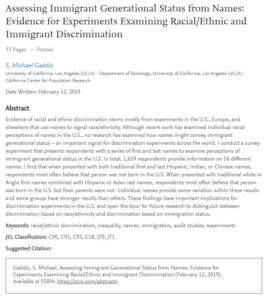
Assessing Immigrant Generational Status from Names: Evidence for Experiments Examining Racial/Ethnic and Immigrant Discrimination
Abstract
Evidence of racial and ethnic discrimination stems mostly from experiments in the U.S., Europe, and elsewhere that use names to signal race/ethnicity. Although recent work has examined individual racial perceptions of names in the U.S., no research has examined how names might convey immigrant generational status – an important signal for discrimination experiments across the world. I conduct a survey experiment that presents respondents with a series of first and last names to examine perceptions of immigrant generational status in the U.S. In total, 1,659 respondents provide information on 56 different names. I find that when presented with both traditional first and last Hispanic, Indian, or Chinese names, respondents most often believe that person was not born in the U.S. When presented with traditional white or Anglo first names combined with Hispanic or Asian last names, respondents most often believe that person was born in the U.S. but their parents were not. Individual names provide some variation within these results and some groups have stronger results than others. These findings have important implications for discrimination experiments in the U.S. and open the door for future research to distinguish between discrimination based on race/ethnicity and discrimination based on immigration status.
Keywords
-
Immigration
-
Racial/ethnic discrimination
-
Names
-
Audit Studies
- Experiments
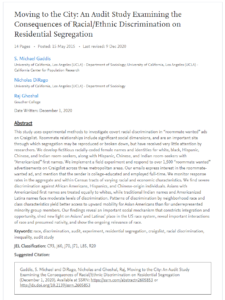
Moving to the City: An Audit Study Examining the Consequences of Racial/Ethnic Discrimination on Residential Segregation
Abstract
This study uses experimental methods to investigate covert racial discrimination in “roommate wanted” ads on Craigslist. Roommate relationships include significant social dimensions, and are an important site through which segregation may be reproduced or broken down, but have received very little attention by researchers. We develop fictitious racially-coded female names and identities for white, black, Hispanic, Chinese, and Indian room-seekers, along with Hispanic, Chinese, and Indian room-seekers with “Americanized” first names. We implement a field experiment and respond to over 1,500 “roommate wanted” advertisements on Craigslist across three metropolitan areas. Our emails express interest in the roommate-wanted ad, and mention that the sender is college-educated and employed full-time. We monitor response rates in the aggregate and within Census tracts of varying racial and economic characteristics. We find severe discrimination against African Americans, Hispanics, and Chinese-origin individuals. Asians with Americanized first names are treated equally to whites, while traditional Indian names and Americanized Latina names face moderate levels of discrimination. Patterns of discrimination by neighborhood race and class characteristics yield better access to upward mobility for Asian Americans than for underrepresented minority group members. Our findings reveal an important social mechanism that constricts integration and opportunity, shed new light on Asians’ and Latinas’ place in the US race system, reveal important interactions of race and presumed nativity, and show the ongoing relevance of race.
Keywords
-
Housing
-
Racial/ethnic discrimination
-
Audit studies
-
Experiments
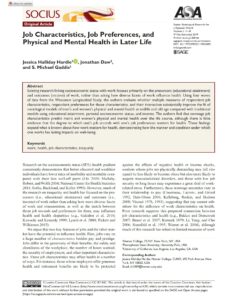
Job Characteristics, Job Preferences, and Physical and Mental Health in Later Life
Abstract
Existing research linking socioeconomic status with work focuses primarily on the precursors (educational attainment) and outcomes (income) of work, rather than asking how diverse facets of work influence health. Using four waves of data from the Wisconsin Longitudinal Study, the authors evaluate whether multiple measures of respondent job characteristics, respondent preferences for those characteristics, and their interaction substantially improve the fit of sociological models of men’s and women’s physical and mental health at midlife and old age compared with traditional models using educational attainment, parental socioeconomic status, and income. The authors find that nonwage job characteristics predict men’s and women’s physical and mental health over the life course, although there is little evidence that the degree to which one’s job accords with one’s job preferences matters for health. These findings expand what is known about how work matters for health, demonstrating how the manner and condition under which one works has lasting impacts on well-being.
Keywords
- Work
-
Health
-
Inequality
- Job characteristics

Audit Studies: Behind the Scenes with Theory, Method, and Nuance
Abstract
This book offers practical instruction on the use of audit studies in the social sciences. It features essays from sociologists, economists, and other experts who have employed this powerful and flexible tool. Readers will learn how to implement an audit study to examine a variety of questions in their own research. The essays first discuss situations where audit studies are the most effective. These tools allow researchers to make strong causal claims and explore questions that are often difficult to answer with observational data. Audit studies also stand as the single best way to conduct research on discrimination. The authors highlight what these studies have uncovered about labor market processes in the past decade. The next section gives some guidance on how to design an audit study. The essays cover the difficult task of getting a study through an institutional review board, the technical setup of matching procedures, and statistical power and analysis techniques.
The last part focuses on more advanced aspects. Coverage includes understanding context, what variables may signal, and the use of technology. The book concludes with a discussion of challenges and limitations with an eye towards the future of audit studies.
“Field experiments studying and testing for housing and labor market discrimination have, rightly, become the dominant mode of discrimination-related research in economics and sociology. This book brings together a number of interesting and useful perspectives on these field experiments. Many different kinds of readers will find it valuable, ranging from those interested in getting an overview of the evidence, to researchers looking for guidance on the nuts and bolts of conducting these complex experiments.”
David Neumark, Chancellor’s Professor of Economics at the University of California – Irvine
“For decades, researchers have used experimental audit studies to uncover discrimination in a variety of markets. Although this approach has become more popular in recent years, few publications provide detailed information on the design and implementation of the method. This volume provides the first deep examination of the audit method, with details on the practical, political, analytical, and theoretical considerations of this research. Social scientists interested in consuming or contributing to this literature will find this volume immensely useful.”
Devah Pager, Professor of Sociology and Public Policy at Harvard University
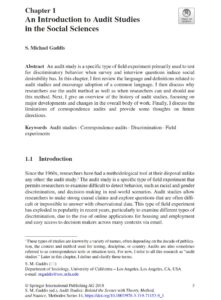
An Introduction to Audit Studies in the Social Sciences
Abstract
An audit study is a specific type of field experiment primarily used to test for discriminatory behavior when survey and interview questions induce social desirability bias. In this chapter, I first review the language and definitions related to audit studies and encourage adoption of a common language. I then discuss why researchers use the audit method as well as when researchers can and should use this method. Next, I give an overview of the history of audit studies, focusing on major developments and changes in the overall body of work. Finally, I discuss the limitations of correspondence audits and provide some thoughts on future directions.
Keywords
-
Audit studies
-
Racial/ethnic discrimination
-
In-depth review
-
Experiments
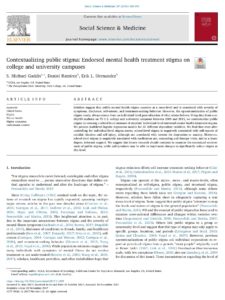
Contextualizing Public Stigma: Endorsed Mental Health Treatment Stigma on College Campuses
Abstract
Scholars suggest that public mental health stigma operates at a meso-level and is associated with severity of symptoms, disclosure, self-esteem, and treatment-seeking behavior. However, the operationalization of public stigma nearly always comes from an individual-level generalization of what others believe. Using data from over 60,000 students on 75 U.S. college and university campuses between 2009 and 2015, we contextualize public stigma by creating a school-level measure of students’ individual-level endorsed mental health treatment stigma. We present multilevel logistic regression models for 21 different dependent variables. We find that even after controlling for individual-level stigma scores, school-level stigma is negatively associated with self-reports of suicidal ideation and self-injury, although not associated with screens for depression or anxiety. Moreover, school-level stigma is negatively associated with medication use, counseling and therapy visits, and to a lesser degree, informal support. We suggest that future research should continue to examine the contextual environment of public stigma, while policymakers may be able to implement changes to significantly reduce stigma at this level.
Keywords
-
Stigma
-
Mental health
-
Higher education
-
Institutional context
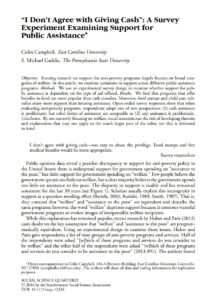
“I Don't Agree with Giving Cash”: A Survey Experiment Examining Support for Public Assistance
Abstract
Existing research on support for anti‐poverty programs largely focuses on broad categories of welfare. In this article, we examine variations in support across different public assistance programs. We use an experimental survey design to examine whether support for public assistance is dependent on the type of aid offered. We find that programs that offer benefits in‐kind are more popular than cash transfers. Moreover, food stamps and child‐care subsidies enjoy more support than housing assistance. Open‐ended survey responses show that when evaluating anti‐poverty programs, respondents adopt one of two perspectives: (1) cash assistance is problematic but other forms of assistance are acceptable or (2) any assistance is problematic. By too narrowly focusing on welfare, social scientists run the risk of developing theories and explanations that may not apply to the much larger part of the safety net that is delivered in‐kind.
Keywords
- Poverty
-
Public assistance
-
Public opinion
- Survey experiment
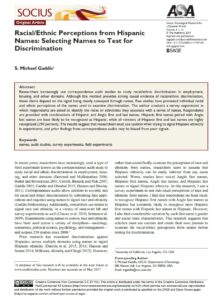
Racial/Ethnic Perceptions from Hispanic Names: Selecting Names to Test for Discrimination
Abstract
Researchers increasingly use correspondence audit studies to study racial/ethnic discrimination in employment, housing, and other domains. Although this method provides strong causal evidence of racial/ethnic discrimination, these claims depend on the signal being clearly conveyed through names. Few studies have pretested individual racial and ethnic perceptions of the names used to examine discrimination. The author conducts a survey experiment in which respondents are asked to identify the races or ethnicities they associate with a series of names. Respondents are provided with combinations of Hispanic and Anglo first and last names. Hispanic first names paired with Anglo last names are least likely to be recognized as Hispanic, while all versions of Hispanic first and last names are highly recognized (≥90 percent). The results suggest that researchers must use caution when trying to signal Hispanic ethnicity in experiments, and prior findings from correspondence audits may be biased from poor signals.
Keywords
-
Names
-
Racial/ethnic discrimination
-
Audit studies
-
Experiments
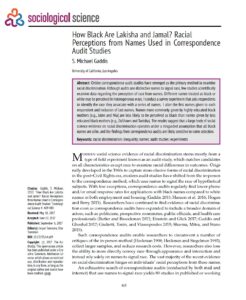
How Black are Lakisha and Jamal? Racial Perceptions from Names Used in Correspondence Audit Studies
Abstract
Online correspondence audit studies have emerged as the primary method to examine racial discrimination. Although audits use distinctive names to signal race, few studies scientifically examine data regarding the perception of race from names. Different names treated as black or white may be perceived in heterogeneous ways. I conduct a survey experiment that asks respondents to identify the race they associate with a series of names. I alter the first names given to each respondent and inclusion of last names. Names more commonly given by highly educated black mothers (e.g., Jalen and Nia) are less likely to be perceived as black than names given by less educated black mothers (e.g., DaShawn and Tanisha). The results suggest that a large body of social science evidence on racial discrimination operates under a misguided assumption that all black names are alike, and the findings from correspondence audits are likely sensitive to name selection.
Keywords
-
Names
-
Racial/ethnic discrimination
-
Audit studies
-
Experiments
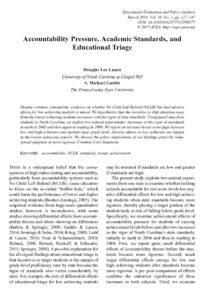
Accountability Pressure, Academic Standards, and Educational Triage
Abstract
Despite common conceptions, evidence on whether No Child Left Behind (NCLB) has had adverse effects for low achieving students is mixed. We hypothesize that the incentive to shift attention away from the lowest achieving students increases with the rigor of state standards. Using panel data from students in North Carolina, we exploit two natural experiments: increases in the rigor of standards in math in 2006 and then again in reading in 2008. We report an increase in test score gaps between low and high achievers and students near grade level. Adverse effects on low achievers are largest in the lowest achieving schools. We discuss the policy implications of our findings given the widespread adoption of more rigorous Common Core Standards.
Keywords
- Educational accountability
-
NCLB
-
Educational triage
- Academic standards
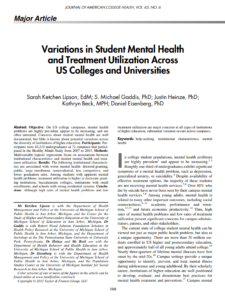
Variations in Student Mental Health and Treatment Utilization Across US Colleges and Universities
Abstract
On US college campuses, mental health problems are highly prevalent, appear to be increasing, and are often untreated. Concerns about student mental health are well documented, but little is known about potential variations across the diversity of institutions of higher education. Participants were 43,210 undergraduates at 72 campuses that participated in the Healthy Minds Study from 2007 to 2013. Multivariable logistic regressions focus on associations between institutional characteristics and student mental health and treatment utilization. The following institutional characteristics are associated with worse mental health: doctoral-granting, public, large enrollment, nonresidential, less competitive, and lower graduation rates. Among students with apparent mental health problems, treatment utilization is higher at doctorate-granting institutions, baccalaureate colleges, institutions with small enrollments, and schools with strong residential systems. Although high rates of mental health problems and low treatment utilization are major concerns at all types of institutions of higher education, substantial variation occurs across campuses.
Keywords
- Mental health help-seeking / treatment
-
Mental health
-
Higher education
- Institutional context
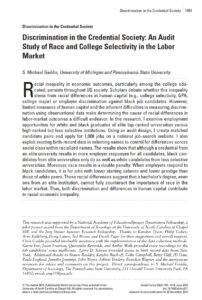
Discrimination in the Credential Society: An Audit Study of Race and College Selectivity in the Labor Market
Abstract
Racial inequality in economic outcomes, particularly among the college educated, persists throughout US society. Scholars debate whether this inequality stems from racial differences in human capital (e.g., college selectivity, GPA, college major) or employer discrimination against black job candidates. However, limited measures of human capital and the inherent difficulties in measuring discrimination using observational data make determining the cause of racial differences in labor-market outcomes a difficult endeavor. In this research, I examine employment opportunities for white and black graduates of elite top-ranked universities versus high-ranked but less selective institutions. Using an audit design, I create matched candidate pairs and apply for 1,008 jobs on a national job-search website. I also exploit existing birth-record data in selecting names to control for differences across social class within racialized names. The results show that although a credential from an elite university results in more employer responses for all candidates, black candidates from elite universities only do as well as white candidates from less selective universities. Moreover, race results in a double penalty: When employers respond to black candidates, it is for jobs with lower starting salaries and lower prestige than those of white peers. These racial differences suggest that a bachelor’s degree, even one from an elite institution, cannot fully counteract the importance of race in the labor market. Thus, both discrimination and differences in human capital contribute to racial economic inequality.
Keywords
-
Labor market
-
Racial/ethnic discrimination
-
Educational credentials
-
Audit studies
-
Experiments
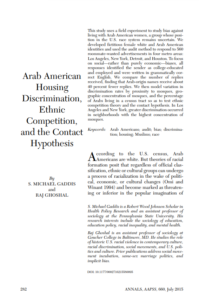
Arab American Housing Discrimination, Ethnic Competition, and the Contact Hypothesis
Abstract
This study uses a field experiment to study bias against living with Arab American women, a group whose position in the U.S. race system remains uncertain. We developed fictitious female white and Arab American identities and used the audit method to respond to 560 roommate-wanted advertisements in four metro areas: Los Angeles, New York, Detroit, and Houston. To focus on social—rather than purely economic—biases, all responses identified the sender as college-educated and employed and were written in grammatically correct English. We compare the number of replies received, finding that Arab-origin names receive about 40 percent fewer replies. We then model variation in discrimination rates by proximity to mosques, geographic concentration of mosques, and the percentage of Arabs living in a census tract so as to test ethnic competition theory and the contact hypothesis. In Los Angeles and New York, greater discrimination occurred in neighborhoods with the highest concentration of mosques.
Keywords
- Racial/ethnic discrimination
-
Housing inequality
-
Audit Studies
- Experiments
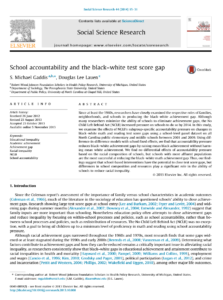
School Accountability and the Black-White Test Score Gap
Abstract
Since at least the 1960s, researchers have closely examined the respective roles of families, neighborhoods, and schools in producing the black–white achievement gap. Although many researchers minimize the ability of schools to eliminate achievement gaps, the No Child Left Behind Act (NCLB) increased pressure on schools to do so by 2014. In this study, we examine the effects of NCLB’s subgroup-specific accountability pressure on changes in black–white math and reading test score gaps using a school-level panel dataset on all North Carolina public elementary and middle schools between 2001 and 2009. Using difference-in-difference models with school fixed effects, we find that accountability pressure reduces black–white achievement gaps by raising mean black achievement without harming mean white achievement. We find no differential effects of accountability pressure based on the racial composition of schools, but schools with more affluent populations are the most successful at reducing the black–white math achievement gap. Thus, our findings suggest that school-based interventions have the potential to close test score gaps, but differences in school composition and resources play a significant role in the ability of schools to reduce racial inequality.
Keywords
- Educational inequality
-
Achievement gap
-
Racial inequality
- NCLB school accountability
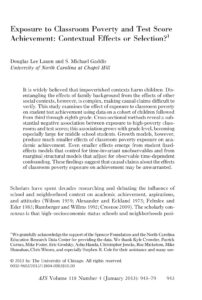
Exposure to Classroom Poverty and Test Score Achievement: Contextual Effects or Selection?
Abstract
It is widely believed that impoverished contexts harm children. Disentangling the effects of family background from the effects of other social contexts, however, is complex, making causal claims difficult to verify. This study examines the effect of exposure to classroom poverty on student test achievement using data on a cohort of children followed from third through eighth grade. Cross-sectional methods reveal a substantial negative association between exposure to high-poverty classrooms and test scores; this association grows with grade level, becoming especially large for middle school students. Growth models, however, produce much smaller effects of classroom poverty exposure on academic achievement. Even smaller effects emerge from student fixed-effects models that control for time-invariant unobservables and from marginal structural models that adjust for observable time-dependent confounding. These findings suggest that causal claims about the effects of classroom poverty exposure on achievement may be unwarranted.
Keywords
-
Educational inequality
-
School poverty
- Institutional context
- Academic achievement
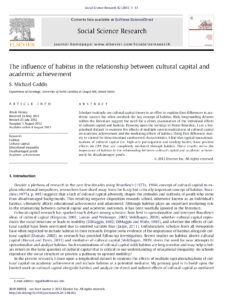
The Influence of Habitus in the Relationship between Cultural Capital and Academic Achievement
Abstract
Since at least the 1960s, researchers have closely examined the respective roles of families, neighborhoods, and schools in producing the black–white achievement gap. Although many researchers minimize the ability of schools to eliminate achievement gaps, the No Child Left Behind Act (NCLB) increased pressure on schools to do so by 2014. In this study, we examine the effects of NCLB’s subgroup-specific accountability pressure on changes in black–white math and reading test score gaps using a school-level panel dataset on all North Carolina public elementary and middle schools between 2001 and 2009. Using difference-in-difference models with school fixed effects, we find that accountability pressure reduces black–white achievement gaps by raising mean black achievement without harming mean white achievement. We find no differential effects of accountability pressure based on the racial composition of schools, but schools with more affluent populations are the most successful at reducing the black–white math achievement gap. Thus, our findings suggest that school-based interventions have the potential to close test score gaps, but differences in school composition and resources play a significant role in the ability of schools to reduce racial inequality.
Keywords
- Educational inequality
-
Cultural capital
-
Academic achievement
- Disadvantaged youth
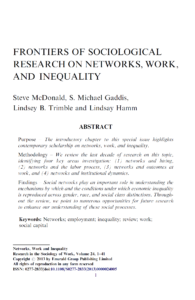
Frontiers of Sociological Research on Networks, Work, and Inequality
Abstract
The introductory chapter to this special issue highlights contemporary scholarship on networks, work, and inequality. We review the last decade of research on this topic, identifying four key areas investigation: (1) networks and hiring, (2) networks and the labor process, (3) networks and outcomes at work, and (4) networks and institutional dynamics. Social networks play an important role in understanding the mechanisms by which and the conditions under which economic inequality is reproduced across gender, race, and social class distinctions. Throughout the review, we point to numerous opportunities for future research to enhance our understanding of these social processes.
Keywords
-
Networks
-
Labor market / employment
-
Inequality
- Social capital
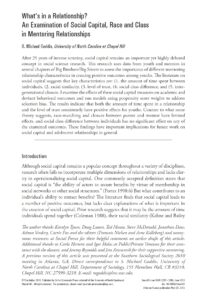
What's in a Relationship? An Examination of Social Capital, Race and Class in Mentoring Relationships
Abstract
After 25 years of intense scrutiny, social capital remains an important yet highly debated concept in social science research. This research uses data from youth and mentors in several chapters of Big Brothers/Big Sisters to assess the importance of different mentoring relationship characteristics in creating positive outcomes among youths. The literature on social capital suggests that key characteristics are: (1. the amount of time spent between individuals, (2. racial similarity, (3. level of trust, (4. social class difference, and (5. intergenerational closure. I examine the effects of these social capital measures on academic and deviant behavioral outcomes and run models using propensity score weights to address selection bias. The results indicate that both the amount of time spent in a relationship and the level of trust consistently have positive effects for youths. Counter to what some theory suggests, race-matching and closure between parent and mentor have limited effects, and social class difference between individuals has no significant effect on any of the examined outcomes. These findings have important implications for future work on social capital and adolescent relationships in general
Keywords
- Racial/ethnic inequality
-
Social capital
-
Educational inequality
- Mentoring relationships
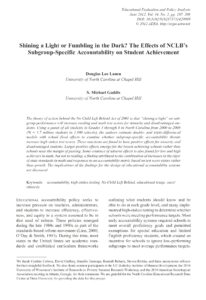
Shining a Light or Fumbling in the Dark? The Effects of NCLB’s Subgroup-Specific Accountability on Student Achievement
Abstract
The theory of action behind the No Child Left Behind Act of 2001 is that “shining a light” on subgroup performance will increase reading and math test scores for minority and disadvantaged students. Using a panel of all students in Grades 3 through 8 in North Carolina from 2000 to 2008 (N = 1.7 million students in 1,800 schools), the authors estimate double- and triple-differenced models with school fixed effects to examine whether subgroup-specific accountability threats increase high-stakes test scores. These sanctions are found to have positive effects for minority and disadvantaged students. Larger positive effects emerge for the lowest achieving schools rather than schools near the margin of passing. Some evidence of adverse effects is also found for low and high achievers in math, but not in reading, a finding attributed to the combination of increases in the rigor of state standards in math and responses to an accountability metric based on test score status rather than growth. The implications of the findings for the design of educational accountability systems are discussed.
Keywords
-
Educational accountability
-
Race/ethnicity
- Inequality
- High-stakes testing
- Educational triage
